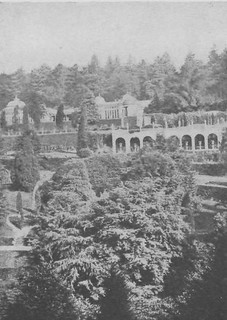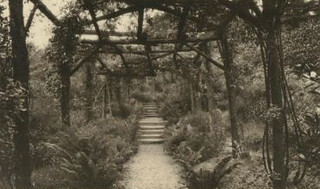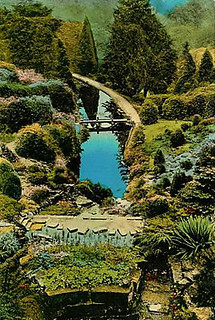The Gardens at Alton Towers are one of the oldest parts of the park and are steeped in a rich history. And whilst they are a beautiful spot to take a stroll through any time, today we’re going to take a step back in time and take a tour through the Gardens as they were seen by guests throughout the past two centuries.
1. Shot Tower
 We’ll start our stroll at the Shot Tower, which these days acts as the entrance point to Hex, Dark Forest and The World of David Walliams, but which once was the main vehicular access to the Towers themselves.
We’ll start our stroll at the Shot Tower, which these days acts as the entrance point to Hex, Dark Forest and The World of David Walliams, but which once was the main vehicular access to the Towers themselves.
In fact cars would have regularly driven up this driveway right through to the 1980s, when much of the park was pedestrianised. Our photo takes us back to the 1950s, quite possibly 1951 when the house was returned to public ownership for the first time since the war.
From the Shot Tower turn left and enter the gardens via the path to the left of the Archway Kiosk, follow this path and you will soon arrive at the:
2. Swiss Cottage
 The Swiss Cottage is an intriguing little house nestled on the South Side of the valley. It once housed a blind Welsh harpist, Edward Jervis, who the Earl of Shrewsbury retained to entertain his guests when they visited the Gardens.
The Swiss Cottage is an intriguing little house nestled on the South Side of the valley. It once housed a blind Welsh harpist, Edward Jervis, who the Earl of Shrewsbury retained to entertain his guests when they visited the Gardens.
As you approach, you’ll notice two doors on the side of the building. If you were seeking the original entrance to the house you might be forgiven for heading towards the porch with the larger double doors, but this is actually a later addition to the building, as seen in this photo from the early 80s. Indeed this extension, the terrace on the front of the building as well as the double doors on the terrace were all added during the 1980s to make the building more suitable as a restaurant.
The original main entrance to the building is actually the much smaller, single door, on the otherwise blank side of the building. The answer as to why such a unimposing entrance was added to such a magnificent building may lay in the original intention of the Earl. As you will discover later in your stroll, this house was built as a garden decoration, intended to be be viewed from a distance and therefore its practicality as a residence was a secondary concern.
Once you’ve finished looking at the cottage head onto terrace and take in the:
3. View from the Swiss Cottage
 Today the Swiss Cottage offers one of the most splendid views of the Grand Conservatories and the surrounding terraces, but in the 1800s similar views would have been available from spots across the entire South side of the valley, as seen in this rare photo from 1871, showing a similar view taken from the paths below the Swiss Cottage.
Today the Swiss Cottage offers one of the most splendid views of the Grand Conservatories and the surrounding terraces, but in the 1800s similar views would have been available from spots across the entire South side of the valley, as seen in this rare photo from 1871, showing a similar view taken from the paths below the Swiss Cottage.
Indeed, in the early days, the North side of the Garden would have been clearly visible from the Towers themselves, as seen in many engravings from the time.
If you can tear yourself away from the views, take the path that is hidden behind the tree to the left of the terrace and head down the valley. Ignore the steps to your right and then cross straight over the first path that you come to. When you get to the second crossroads, turn right and head down:
4. Jacobs Ladder
 Jacobs Ladder is probably the most direct route from the Towers into the heart of the Gardens and no doubt would have been a popular access route for the Earls themselves. Consisting of over one hundred stairs, this garden feature has proven to be one of the more tricky to maintain and often sections of the stairway has been closed as nature takes its course on the steps.
Jacobs Ladder is probably the most direct route from the Towers into the heart of the Gardens and no doubt would have been a popular access route for the Earls themselves. Consisting of over one hundred stairs, this garden feature has proven to be one of the more tricky to maintain and often sections of the stairway has been closed as nature takes its course on the steps.
You’ve joined the stairway roughly a third of the way down and are heading all the way to the bottom of the valley. We believe that at one point the Rosary seen in this early postcard was likely to arch over the lower part of the path you are walking down.
When you reach the to the Iron Bridge at the bottom take a moment to take a look up at:
5. The Cascade and Rock Garden
 This is one of the most impressive rockeries in any garden you are likely to visit. Originally the water way was intended to be crossed by a stone bridge but instead The Iron Bridge you see today was installed.
This is one of the most impressive rockeries in any garden you are likely to visit. Originally the water way was intended to be crossed by a stone bridge but instead The Iron Bridge you see today was installed.
Do not cross the bridge but instead turn right and then instantly right again and head down towards the small body of water known as:
6. Dolphin Lake
 Often overshadowed by its larger neighbour, a small fountain bubbles away at the centre of this pleasant little lake. It is not entirely clear as to why this is known as Dolphin Lake, but it may have had something to do with the original fountain that once spouted into the pool.
Often overshadowed by its larger neighbour, a small fountain bubbles away at the centre of this pleasant little lake. It is not entirely clear as to why this is known as Dolphin Lake, but it may have had something to do with the original fountain that once spouted into the pool.
The rockwork fountain we see today has been in place since before the Second World War, as seen in this pre-war postcard, but originally the fountain here would have been a tall a graceful pedestal, which potentially featured some sort of dolphin decoration.
Circle the lake and head down either side of the Pagoda Fountain until you find yourself at the far left hand corner of that lake, then turn left and take the zig zag path up the side of the valley. When you reach the top of that path you will be directly below the Skyride and on the path known as:
7. The Rock Walk
 Many of the features found in the Garden take advantage of the natural rockwork found throughout the valley. The Gardens’ designers were fond of carving straight into the rock, as is the case with these steps, which are hidden to your left behind a tree.
Many of the features found in the Garden take advantage of the natural rockwork found throughout the valley. The Gardens’ designers were fond of carving straight into the rock, as is the case with these steps, which are hidden to your left behind a tree.
Once you found the steps climb them to the Forbidden Valley Skyride station and the turn left along the path to the Prospect Tower.
If the Rock Steps are unavailable, an alternative route can be found by doubling back on yourself and taking the first right which will lead you onto the paths up to:
8. The Prospect Tower
 The recently restored Prospect Tower is another spot to catch some breathtaking views of the Gardens with the Towers beyond, but we suspect these guests from 1959 would have had even better views back when guests could still climb the tower.
The recently restored Prospect Tower is another spot to catch some breathtaking views of the Gardens with the Towers beyond, but we suspect these guests from 1959 would have had even better views back when guests could still climb the tower.
Notice the utilitarian railings featured in the 1959 photo compared to the much more decorative barriers you see today. It is not clear exactly why the decorative railings were originally removed, but the more basic design was added after the war to allow guests up the tower and were in place right through to when the Prospect Tower was restored in 2015.
Take one last look at the view before heading back down from the Tower on onto the path directly below, turn left onto that path and you will soon arrive at:
9. The Corkscrew Fountain
 As we’re here, it would be rude not to take a sneaky peak at the Corkscrew Fountain, which predated it’s more thrilling rollercoaster counterpart by 150 years.
As we’re here, it would be rude not to take a sneaky peak at the Corkscrew Fountain, which predated it’s more thrilling rollercoaster counterpart by 150 years.
Turn left at the fountain and head down the path towards the:
10. Yew Arches
 Today the arched walkway is well known for it’s chunky appearance, but this was not always the case. Up to the war, the yew arches were much more slender, which may be why they are also known as the Horseshoe Walk, due to the distinctive shape the arches once had.
Today the arched walkway is well known for it’s chunky appearance, but this was not always the case. Up to the war, the yew arches were much more slender, which may be why they are also known as the Horseshoe Walk, due to the distinctive shape the arches once had.
Head through the arches and you’ll soon emerge at:
11. The Grotto
 Hands down one of our favourite structures in the Garden, the more formal domed Summer House atop has a hidden alcove below, filled with naturalistic rockwork and ferns. This one structure demonstrates the Earl’s desire to lay out a formal garden but at the same time subvert the norm by allowing guests to descend the spiral staircase and into the fantastical world below.
Hands down one of our favourite structures in the Garden, the more formal domed Summer House atop has a hidden alcove below, filled with naturalistic rockwork and ferns. This one structure demonstrates the Earl’s desire to lay out a formal garden but at the same time subvert the norm by allowing guests to descend the spiral staircase and into the fantastical world below.
In many ways the dual nature of the Summerhouse suggests that the Earl would entirely approve of the pleasure park his estate now houses, where thousands of people can enter a world of fantasy each day.
Once you’ve finished exploring the Grotto head up to the Summer House above and then make your way along the path by:
12. The Conservatories
 No visit to the Gardens is complete without a trip to the Grand Conservatories, as seen in this pre-war postcard.
No visit to the Gardens is complete without a trip to the Grand Conservatories, as seen in this pre-war postcard.
For a long time one of the more unusual features of the Conservatories was a solitary Palm Tree that had grown unchecked for over 50 years, breaking through the glass roof and out into the Staffordshire tropics. Alas, all good things must come to an end and in order to restore the integrity of the structure the palm tree was removed during the most recent restoration work in 2017.
Continuing along the terrace, you’ll pass under a solitary Yew Arch and find yourself at:
15. The Dutch Garden
 These days the Dutch Garden is dominated by its statuary, but before the war it acted as one of the Rose Gardens and was absolutely packed to the brim with plants.
These days the Dutch Garden is dominated by its statuary, but before the war it acted as one of the Rose Gardens and was absolutely packed to the brim with plants.
From the Dutch Garden you also get a great view of:
14. The Swiss Cottage
 From this side of the valley you get the intended view of The Swiss Cottage, looking like a model nestled on an alpine slope. Indeed for most guest, this would have been their only experience of the cottage and very few would ever have ventured up to the building itself.
From this side of the valley you get the intended view of The Swiss Cottage, looking like a model nestled on an alpine slope. Indeed for most guest, this would have been their only experience of the cottage and very few would ever have ventured up to the building itself.
Turning back onto the main path and heading right you’ll soon find yourself at:
15. The Choragic Monument
 For most it might be the first structure they come to in the Garden, for us The Choragic Monument is almost the last, and it’s a good chance to remember the man who’s vision planted the seeds (both figurative and literal) that grew into the Gardens we’ve been strolling through today. Indeed without the vision of Charles Talbot it is unlikely the theme park we know today would exist at Alton Towers.
For most it might be the first structure they come to in the Garden, for us The Choragic Monument is almost the last, and it’s a good chance to remember the man who’s vision planted the seeds (both figurative and literal) that grew into the Gardens we’ve been strolling through today. Indeed without the vision of Charles Talbot it is unlikely the theme park we know today would exist at Alton Towers.
These days the bed in front of the earl has been marked with S for Shrewsbury and whilst that has been the case for the past few years, for many years this bed was frequently switched. It seems that the gardeners would use this bed as an opportunity to show off inspiring or cutting edge designs to guests as they entered the gardens, such as in this pre-war postcard.
Before we leave the Gardens nip around the back of the monument to get one last view from the:
16. Top of the Cascade
 We’ve come a very long way since we were last at the Cascade, but we couldn’t leave the Gardens without taking a quick look at this iconic view that has wowed visitors to the estate for almost 200 years. The view may have changed dramatically since the first seeds were planted in the valley, but it is a certainty that the Earl of Shrewsbury himself once stood on this very spot as he surveyed the paradise he had created.
We’ve come a very long way since we were last at the Cascade, but we couldn’t leave the Gardens without taking a quick look at this iconic view that has wowed visitors to the estate for almost 200 years. The view may have changed dramatically since the first seeds were planted in the valley, but it is a certainty that the Earl of Shrewsbury himself once stood on this very spot as he surveyed the paradise he had created.
If you have time there’s still plenty of other spots to explore in the Gardens, but if you’re heading out, from the front of the Choragic Monument, turn left along the path and you can see the White Bridge that acts as the formal entrance to the Garden, follow that path and you’ll soon find yourself back at the Shot Tower where we began.
When you get back to Towers Street don’t forget to take one last look at:
17. The View of the Towers
 A sight that awed thousands of visitors during the tenancy of the Earls of Shrewsbury and many millions more since the modern pleasure park was founded. If you’d been in this spot 50 years ago, not only would you have seen the Towers, but also the park’s fleet of rowing boats, as seen in this post-war postcard.
A sight that awed thousands of visitors during the tenancy of the Earls of Shrewsbury and many millions more since the modern pleasure park was founded. If you’d been in this spot 50 years ago, not only would you have seen the Towers, but also the park’s fleet of rowing boats, as seen in this post-war postcard.

